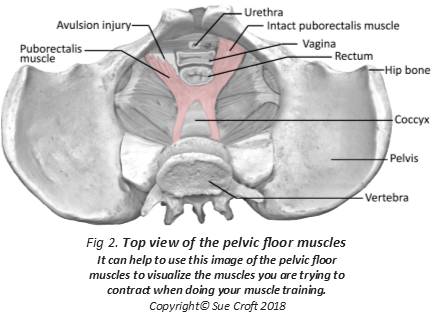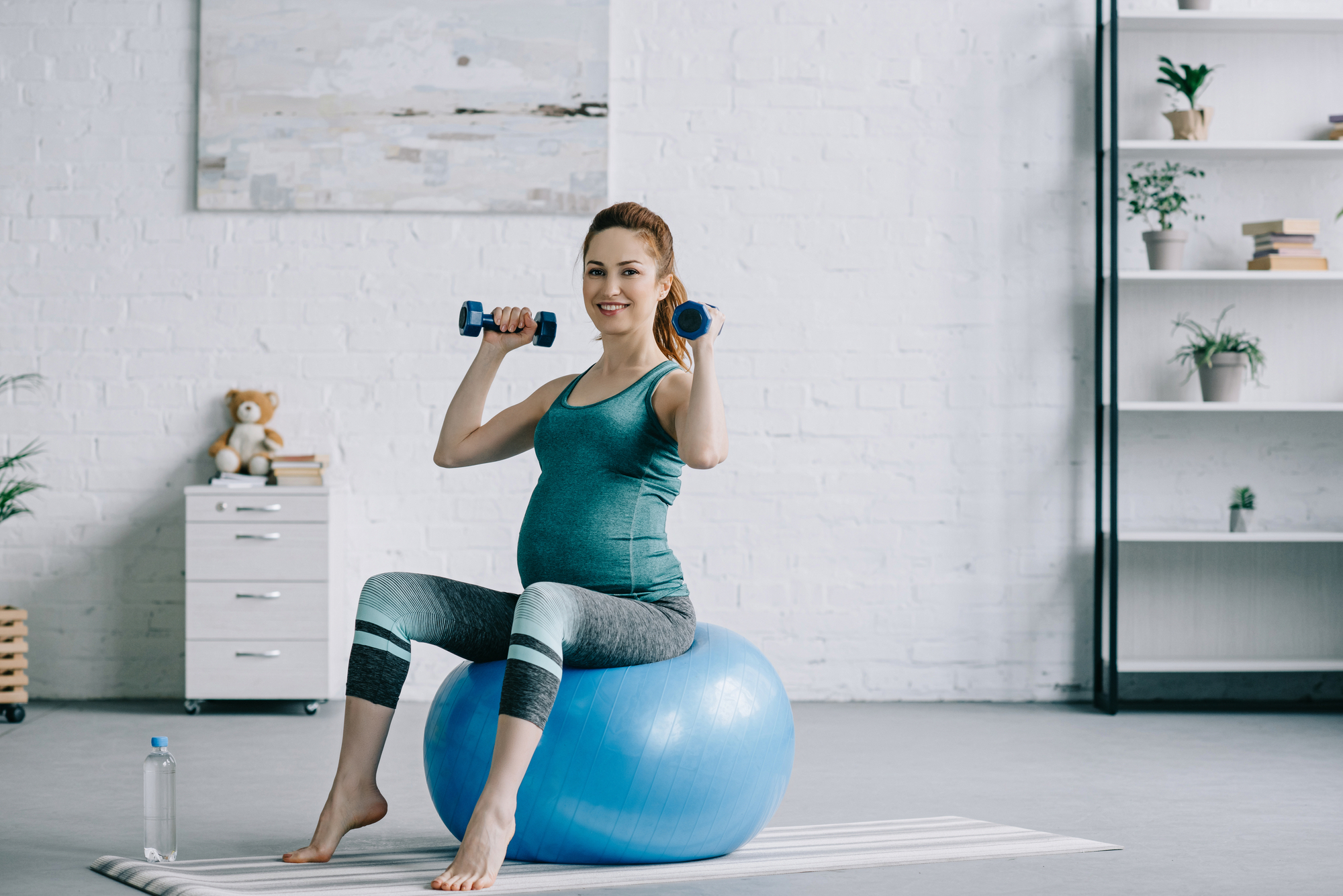By Sue Croft, Pelvic Health Physiotherapist, Co-Chair Scientific Committee NCOI2020, Author Pelvic Floor Recovery: Physiotherapy for Gynaecological and Colorectal Repair Surgery and Pelvic Floor Essentials. www.pelvicfloorrecovery.com
There is so much to get excited about when you’re pregnant. From creating the nursery, checking out the most adaptable pram, the slickest breast-feeding pumps, to hunting out your favourite baby names.
Getting excited about doing pelvic floor exercises is far less likely to rate highly on that list.
But the fact is, these exercises really should.
Pelvic floor exercises are far more likely to prevent you from suffering from pelvic floor dysfunction – conditions which sadly impact the lives of many women, especially after pregnancy and childbirth.
In this article we’ll go through what you need to know and do to make sure you “put your lifejacket on first” by doing your pelvic floor exercises, to make sure you have the best chance of enjoying your wild, but incredible ride throughout pregnancy and motherhood.
Why are pelvic floor exercises important?
Pregnancy and childbirth have a significant effect on your pelvic floor muscles – parts of the body important for urinary control, supporting your internal organs, preventing prolapse, controlling wind and bowel motions, and enjoying sexual function.
And research shows pelvic floor dysfunction is more likely to occur in women during pregnancy and childbirth.
As a women’s health physiotherapist, every day my team and I treat women affected by pelvic floor dysfunction. And this has a major impact on their daily life.
It is linked to increased social isolation, depression, sexual dysfunction and feelings of helplessness and low self-esteem.
And sadly, the silence around pelvic floor dysfunction is deafening.
One research survey revealed 57% of people in a doctor’s waiting room had moderately severe incontinence and yet only 29% of patients had ever raised it with their doctor.
So how do you prevent pelvic floor issues?
The good news is, if you get into some great habits now – even before you get pregnant (or as early in life as you learn of them), you’re far more likely to prevent issues like this happening.
The reality is performing pelvic floor exercises regularly is easy once you know how, they can be readily incorporated into your daily routine for life, and they’re essential to do both antenatally and postnatally.
And even if you have issues, pelvic floor exercises can help. The research tells us women with stress urinary incontinence undertaking pelvic floor muscle training were six times more likely to report being cured or improved, and this is enhanced under the supervision of a physiotherapist.
So how do you create a lifetime habit of great pelvic floor exercises? Here are six steps to create a great pelvic floor exercise regime.
1. Know what are ‘pelvic floor exercises’
The common misconception about ‘pelvic floor exercises’ is women have to get down on the floor to do them. But, you can do them anywhere, any time.
The action you should feel involves lifting and squeezing of your pelvic floor muscles.
2. Get an understanding of where your pelvic floor muscles are and how to ‘activate’ them
The pelvic floor muscles sit at the base of our body and provide the floor of our pelvis. They support the bladder, uterus and rectum and assist with effective function of those organs.
One of the most important concepts in pelvic floor exercising is knowing when to “brace” or activate your pelvic floor, which is tightening your muscles before you cough or sneeze, or with “intra-abdominal” pressure pushing on to the pelvic floor.

3. Know how to correctly activate your pelvic floor with professional advice
Research tells us up to 30% of women perform their pelvic floor muscle contractions incorrectly – which is “bearing down” instead of getting a lifting action – when following a handout and without supervision from a pelvic health physiotherapist.
So, understanding how to correctly activate your pelvic floor muscles often requires the assistance of a pelvic health physiotherapist.
And if you get professional advice, even before you get pregnant, you’re off to an even better start.
If you are already pregnant and cannot feel lift or squeeze and subsequent relaxation of the pelvic floor muscles, you can see a pelvic health physiotherapist for an internal examination during the pregnancy.
But, be sure to check with your obstetrician it’s safe to do so, confirming there are no contraindications to an internal examination. It’s important to wait until after the first trimester of the pregnancy has passed for an internal examination.
Whether you have a vaginal delivery or a caesarean, it is important to check in with a pelvic health physiotherapist to see if there are any issues with nerve or muscle function and to revisit good bladder and bowel habits.
4. What should you know about pelvic floor exercises after birth?
Recommencing pelvic floor exercises early post-partum can help reduce any swelling around the perineum (the area between your legs) and assist with a quicker recovery.
One of the significant vaginal birth injuries that can occur is called ‘levator avulsion’, where one or both attachment points of the pelvic floor muscles can be compromised. If this happens, the strength of your pelvic floor muscles can be significantly affected.
Getting an accurate assessment of your muscles from a pelvic health physiotherapist at six weeks post-partum is important.
If you have any prolapse or urinary or faecal incontinence, early intervention with effective pelvic floor muscle training, bracing and perhaps a pessary to support any prolapse or prevent urinary incontinence will be offered by a pelvic health physiotherapist.
Know some key tips and do’s and don’ts of ‘pelvic floor exercising’
Start by sitting on a firm chair, and imagine you need to pass wind (but you don’t want to) and visualize drawing in your anus while you continue to breathe. Feel the anus lift up and off the chair.
Then try the same action around the vagina.
Another way to check your pelvic floor action is to try stopping the flow of urine, but don’t do this anymore regularly than once a month.
Remember you should feel lift and squeeze pressure, not any pushing down sensation.
It is important to build up the endurance of your pelvic floor muscles when practising your exercises, because when a strong urinary urge hits, you need to be able to sometimes hold the contraction of your pelvic floor muscles for 10, 20 or 30 seconds until that urinary urge subsides, in order to hold urine in.
Keep breathing through the contraction and importantly, relax completely.
Finally, here is a quick list of things to be aware of when attempting pelvic floor exercises:
The dos and don’ts of correctly contracting your pelvic floor muscles when first learning them:
- Do not use your inner thigh muscles.
- Do not tilt your pelvis.
- Do not clench your buttocks.
- Do not strongly contract your abdominal muscles.
- Do not hold your breath.
- Do not flare your ribs
- Do not bear down.
- Yes, you should feel lift and squeeze of the pelvic floor as you continue to breathe.
- Yes, your lower tummy may draw gently in.
- Yes, initially gentle is better than trying too hard to ensure the correct activation.
- Yes, when you are sure you have the correct activation, you can add some maximal contractions.
- Yes, always remember to let go and relax your pelvic floor muscles after exercising them.
 Sue Croft has been a physiotherapist for 43 years and for the past 30 years has been working in Pelvic Health Physiotherapy. She has her own practice In Highgate Hill, Brisbane, employing four other physiotherapists working in the area of pelvic floor dysfunction and particularly pelvic pain. Sue has written two patient-directed books: Pelvic Floor Recovery: Physiotherapy for Gynaecological and Colorectal Repair Surgery and Pelvic Floor Essentials which demystify pelvic floor dysfunction and give simple, easy-to-follow strategies for patients. Sue is a passionate advocate for pelvic health issues and speaks at physiotherapy, nursing and medical conferences and does many lectures to the general public. Sue writes a blog (over 330 to date) on Pelvic Floor Dysfunction for the public and health professionals and she has discovered the power of social media such as Twitter, Instagram and Facebook to disseminate information around pelvic health.
Sue Croft has been a physiotherapist for 43 years and for the past 30 years has been working in Pelvic Health Physiotherapy. She has her own practice In Highgate Hill, Brisbane, employing four other physiotherapists working in the area of pelvic floor dysfunction and particularly pelvic pain. Sue has written two patient-directed books: Pelvic Floor Recovery: Physiotherapy for Gynaecological and Colorectal Repair Surgery and Pelvic Floor Essentials which demystify pelvic floor dysfunction and give simple, easy-to-follow strategies for patients. Sue is a passionate advocate for pelvic health issues and speaks at physiotherapy, nursing and medical conferences and does many lectures to the general public. Sue writes a blog (over 330 to date) on Pelvic Floor Dysfunction for the public and health professionals and she has discovered the power of social media such as Twitter, Instagram and Facebook to disseminate information around pelvic health.
Ph: (07)3848 9601 Mob: 0407659357
Find A Physio section of the Australian Physiotherapy Association
https://choose.physio/find-a-physio
Continence Foundation of Australia’s website or the contact phone number for their Helpline is 1800 33 00 66
https://www.continence.org.au/service-providers.php
To view on YouTube:
You may also like to read:









